Summary
- If everyone is using Smart Bidding, the advertiser that provides the best data will gain an edge in the auction.
- Micro conversions can be a way to give more data in cases where you don’t get enough transactions to fuel Smart Bidding.
- Attribution is fundamentally flawed, so adding more conversions to Google isn’t an issue.
- Start simple with the next best conversion behind transactions: add-to-cart conversions → then expand!
Intro
How can you obtain an advantage if everyone is running Smart Bidding?
I’ve spent a lot of time thinking about this question because it’s so fundamental. With Smart Bidding and performance leveling the playing field, how do you stay ahead?
The answer is data—more data and better data in the form of conversion data.
In today’s article, we’ll be discussing how to give Google Ads more data to work with.
Granted, this is not necessarily directed at advertisers that already have plenty of data to work with but advertisers struggling to get non-branded campaigns to be profitable.
There are two things that you need to accept in order for you to adopt the tactics listed in this article:
- Whatever ROAS you see in your Google Ads account is relative.
- True attribution is a myth.
I’ll get into both in this article.
At the end of the day, adding more data means you need to tweak your targets and the way you review performance inside your Google Ads account.
Tracking revenue as a deciding factor in whether a campaign is a success is a short-sighted mistake—especially when you have a long customer journey.
But let’s get into it!
Terminology
The following is a short list of terms used in this article that might be confusing unless you live in the Conversions section of Google Ads:
- Conversion Actions: Is the correct term for the different conversions you create.
- Conversion Action Set: A group of conversions.
- Primary Conversion Action: The conversion actions you want Smart Bidding to use when calculating bids.
- Secondary Conversion Action: All other conversion actions that you don’t want Smart Bidding to use.
Not for All Cases
Note that micro conversions are still not the default setting in Savvy, and I doubt it will ever be a main strategy for us.
We work with larger B2C advertisers that typically have plenty of data. The tactics described in this article are focused on products with longer customer journeys.
These are usually at $500–$1,000 and above in AOV.
SavvySession – Micro Conversions
Watch or rewatch when Andrew takes you through everything you need to know about Micro Conversions in this SavvySession:
https://www.youtube.com/watch?v=JJEb8M0TWYk
Case: High AOV, Long Customer Journey
In one of our most noteworthy cases of successfully implementing micro conversions, we had about zero ability to get the account off the ground.
The business had about $10 million in annual revenue, but all their search advertising was brand-focused.
The initial efforts showed a 50% ROAS for non-brand efforts. Yup. 50%. It was impossible to get buy-in to scale in order to get more data while hoping to fix the ROAS in the future.
In came micro conversions.
We switched to add-to-cart conversions because we theorized that for a long customer journey, the cookie is lost during the customer journey, or the efforts to track non-branded search are otherwise inadequate.
We chose add-to-cart conversions because they were the best we could do. I would ideally have included a few others, but we could implement add-to-cart conversions without waiting for developers to implement them.
Below are the numbers for the first month after we switched to add-to-cart conversions.

Insights:
- We tracked four transactions in that phase for a total revenue of $5,500.
- We spent $14,500 (that’s a ROAS of 35%).
- We tracked 111 add-to-cart conversions.
- Sitewide, of 100 add-to-cart sessions, we saw 34 transactions in Google Analytics. We chose to be pessimistic, as this was 100% cold traffic, so we assumed a 25% conversion rate.
- At an AOV of $1,600, we could assign $400 in revenue per add-to-cart conversion.
- 111 add-to-cart conversions at a $400 theoretical AOV would result in $44,400 in revenue.
- Using the ATC data above, we ended up with a theoretical ROAS of 329%.
We then combined this data with our blended ROAS targets with the Director of Marketing and kept an eye on this.
Over time, we could see that even as we increased spending using the add-to-cart theoretical ROAS metric, the blended ROAS continued to be within the target range.
This means that the add-to-cart conversions were a good leading indicator of transactions—otherwise, the blended ROAS metric would have worsened.
In the following, you can see the anonymized data on how the micro conversions continued to increase, and the blended ROAS kept steady except for a few months.
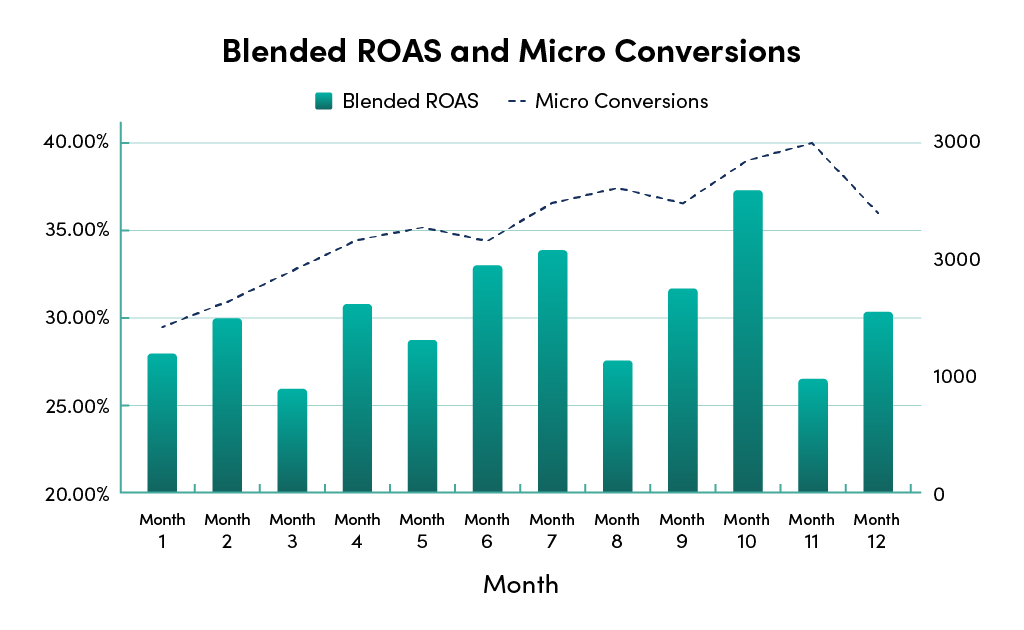
You can also see the revenue increasing month over month alongside the increase in micro conversions.
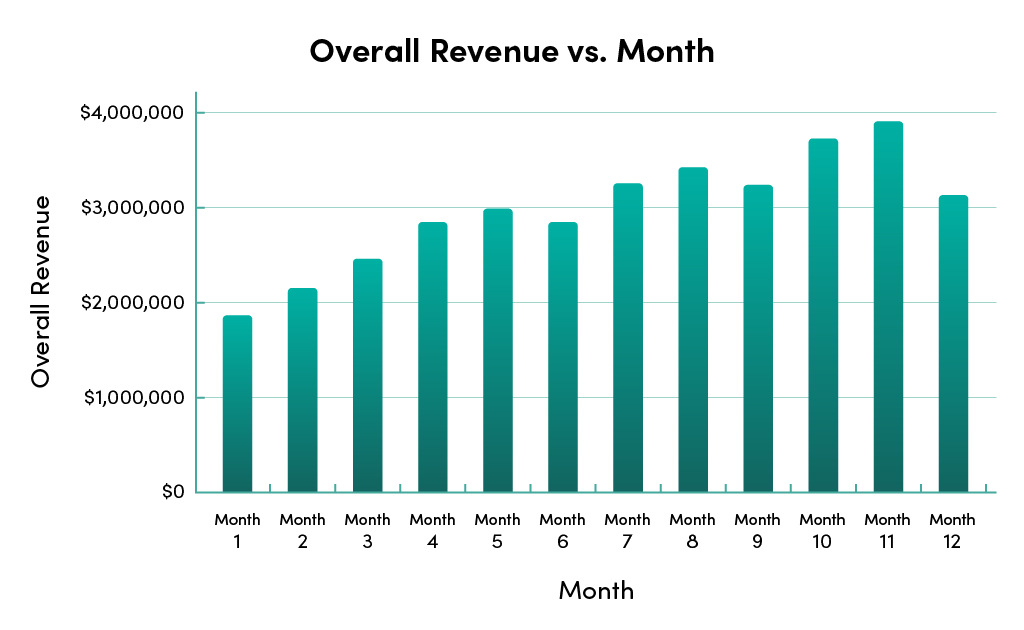
Note: Ideally, we would have liked to run Google Ads conversion tracking with enhanced conversions.
This could have helped tremendously, but as the advertiser was in the middle of a long-term transition to a headless Shopify setup, any investment in the current site was out of the question.
Good and Bad Micro Conversions
Micro conversions are typically small, measurable actions, such as newsletter signups, video views, or add-to-cart events that can qualify whether traffic is likely to lead to a purchase later—or if it was a simple misclick.
Some of my favorite micro conversions in prioritized order are as follows:
- Add to carts
- Newsletter sign-ups
- Live chat engagement
Other options include the following:
- Using features (such as favorited products)
- Video views of a product (to 80–90%)
- Reading reviews
These are typically great supporting micro conversions, but we tend to get more than enough conversions with the first three to fuel Smart Bidding.
However, I’m not too fond of the following micro conversions:
- Quality visits
- Time on site
- Key page views
- Bounce rate
Technically, all of these should reflect whether a visitor was truly interested in a product. However, we haven’t been able to scale accounts using this data as of this moment.
Every time we have tried using these four micro conversions to scale an account, we have not seen a correlation between an increase in spending using these values and still hitting a blended ROAS target.
My theory is that it’s too difficult to apply a value to time on a site or a bounce rate where an add to cart or newsletter signup is easy to calculate.
We’re Dependent on Data.
Micro conversions have been a strategy that has been around for years, but I never really used them.
Three core things happened that required us to revisit micro conversions:
- Cookie pop-ups took away our conversion data, so we needed to find ways to get more data.
- We leaned into automated bidding strategies that require data to be effective.
- Smart Bidding has evened the playing field, so the way to get ahead of the competition is to give the system more/better data.
These three things have meant that we needed to be more inventive about our strategy when launching Google Ads for the first time or when an account has become very brand heavy.
But that’s not the only realization I’ve had over the years. I first wrote about this back in 2021, but attribution is horribly flawed, and I’m almost ashamed of how long it took for me to realize this.
Attribution is Flawed.
As of 2023, I believe most professionals have realized that we can’t play the attribution game. Even if we were to find the perfect attribution solution, then it would mean we gave less data to the algorithms, which would make them less effective—so why would we even use attribution?
Given this realization, we should all strive to give as much data to Google Ads (and any other channel that requires data to be effective) as possible.
For long customer journeys (anything above one week in my opinion), you lose a ton of conversions based on the following:
- Cookies expiring
- Other channels taking credit
- Branded terms taking credit
- Cookie pop-up rejections or ad blockers
This means you have a tougher time proving that non-brand activities are profitable, and you never get to the stage where there is enough data for the algorithms to be truly effective, making it even more difficult to get off the ground.
Micro conversions are ideal for giving more data to the algorithms and helping scale accounts. So let’s discuss how to actually implement them.
How to Implement Micro Conversions in Google Ads
To use micro conversions, take the following steps:
- Identify micro conversions. Typically, these are small, measurable actions, such as newsletter signups, video views, or add-to-cart events, that can show progress toward a larger goal.
- Set up with the Google conversion tag (or in GA4). Once you have identified the micro conversions you want to track, you will need to create a Google conversion tag (or GA4) and import it into Google Ads.
- If in GA4, you then import to Google Ads.
- Set it to count only one conversion (not every conversion).
- Apply a value that represents the value that an action takes.
- Create a custom conversion set where you group together conversions so you can easily apply them on the campaign level.
- Create custom columns for your micro conversions.
- Collect data for 3–4 weeks to get a better understanding of the micro conversions and how they are impacting your overall performance.
- Switch Action Action on your account
Let’s dig into the last four:
C) Apply a Value to the Micro Conversion.
Google Shopping requires a conversion value to be able to use Smart Bidding.
So you need to calculate a value for each micro conversion that Smart Bidding can use and that you can set a ROAS target for.
The best way to calculate this is to use Google Analytics:
- Create a segment where the users have performed your action (i.e., add to cart).
- Calculate the revenue from users performing that action.
- That’s your value per micro conversion.
Examples:
- The total revenue is $1,157,000.

- The number of add-to-cart conversions is 3,484.

The theoretical value per add-to-cart conversion = $332.
You need to set a conservative initial value. I recommend setting it 25% lower than you think and then increasing it in the future.
Setting a too-high value can result in overspending and your blended ROAS increasing. This might make the higher-ups at your company uncomfortable with this approach.
Note: If you sell different products, you might want to calculate different add-to-cart values. For example, for a mattress company selling both mattresses and pillows, you might want to exclude your pillow AOV from your mattress add-to-cart value.
This is where it starts to get tricky, but I trust you get the idea and can take action from here.
D) Create a Custom Goal with Your Conversions.
If you have several micro conversions, then you need to create a custom group for them to be used together at the campaign level.
If you plan on only having one micro conversion or you are changing your entire account to only include micro conversions, you can skip this step.
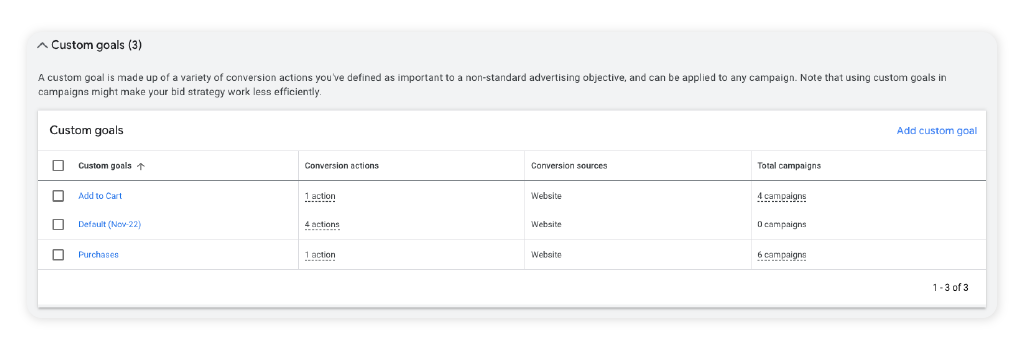
E) Create custom columns.
Because you will have multiple conversions in the conversions column, you need to use custom columns to track the various conversions separately.
For example, it would be nice to see how many newsletter signups vs. add-to-cart conversions there are.
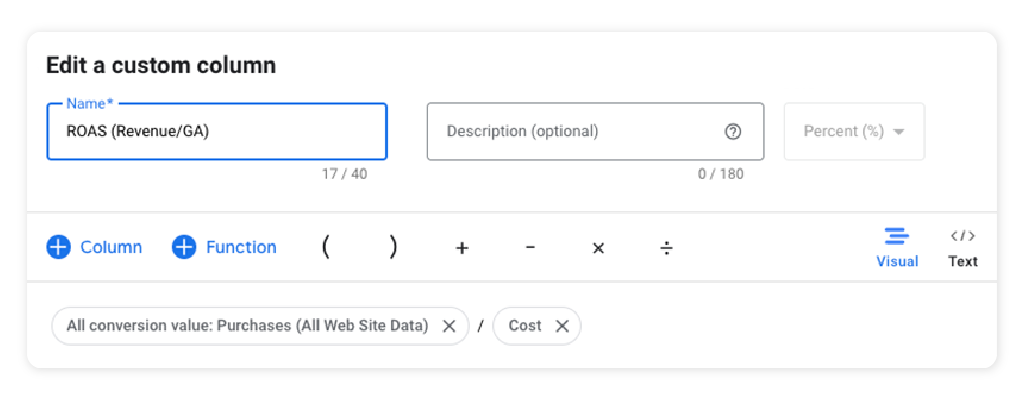
Note: It’s important that you use the All Conversion Value metric. Choosing the All Conversion Value means it includes conversions, regardless of whether it’s set to being the primary or secondary conversion.
If you only choose conversions or the conversion value when setting up a custom column, it will not pull the correct data in when you change from the primary to secondary conversion action.
F) Collect data for 3–4 weeks.
Spend 2–4 weeks just collecting the data before you start managing your bidding based on the data.
Once you have a few weeks’ worth of data, you can start thinking about switching to using Smart Bidding.
To do that, you need to switch out the primary conversion actions on the account.
From here, there are two directions to take based on the scenario:
- You run Smart Bidding on revenue data.
- You run manual bidding with almost no revenue data.
Let’s dig into each scenario.
1) You Run Smart Bidding on Revenue Data Already.
In this case, you need to be careful when switching to micro conversions.
If you set the conversion values perfectly, then this wouldn’t be an issue, but in my experience, it’s hard to get this right.
The reason for this problem is that, let’s say, Smart Bidding is set to target a 300% ROAS.
When you switch to add-to-cart values, you might start seeing a 500% ROAS because there is so much more data available. That means Smart Bidding will increase the bidding—which you might be OK with, but it might be too much.
You might think that you can just increase the ROAS target, but seeing that Smart Bidding uses the data from the last 30 days (and even longer sometimes), you risk taking the old data into account when setting bids, which you don’t want.
So be careful when making the switch.
If you are running standard shopping campaigns, then creating a new portfolio bid strategy can solve the issue.
If you are running Performance Max, I would make the switch and slowly change the ROAS target to suit the data you are seeing on a daily basis until the ROAS is where you want it to be.
2) You run manual bidding with almost no revenue data.
In this case, you don’t have any automation that can be messed up by switching the conversion actions.
Therefore, you can just switch the revenue conversion action to secondary and the new micro conversions to primary when you are ready without any issues.
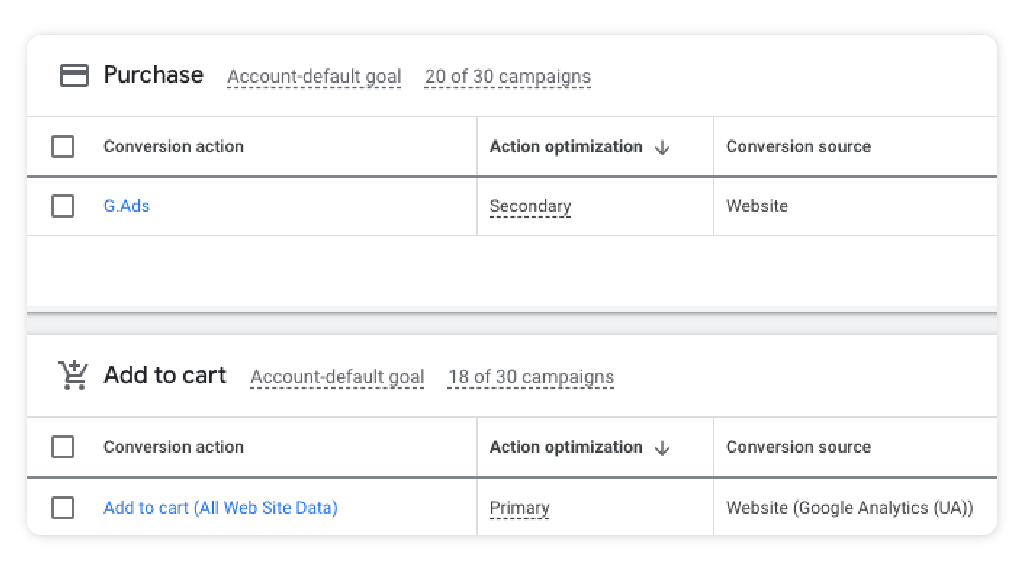
Common Mistakes
Let’s take a look at some of the common mistakes we see:
Too many micro conversions → You are likely to overvalue the total of the micro conversions. So, if a user chatted with a live agent, signed up for the newsletter, and added something to the cart, then it calculates all three values.
You can’t take that into account when calculating the values (as not all users will do all three conversion actions), so you are stuck.
Stick to one or two primary micro conversions.
Unverified conversion values → It’s rarely an issue when you undervalue a micro conversion, as you just increase it in the future. But overvaluing a micro conversion will cause you to scale ads that aren’t profitable.
No reality check → Remember Donnie Brasco? Micro conversions are fugazi, Donnie. Translated to marketing, this means that micro conversions are hot air. It’s not real revenue. They might result in revenue down the line, but it’s not money in the bank.
Therefore, you need a north star metric to ensure that you are not spending money on ads that don’t cause a return. Blended ROAS is that metric.
Not applying a conversion value → As we discussed, Google Shopping needs a conversion value to use Smart Bidding, so this is key.
Choosing micro conversions that are mandatory → We had a client that had a quiz on their site, which they suddenly added to their micro conversion setup.
This skyrocketed the perceived performance, but what they missed was that we had campaigns running where the user had to go through the quiz to get to the site. Sure, this can work, but not when you mix it together with a ton of other micro conversions.
Not setting the micro conversions as the primary conversion action → Smart Bidding can’t be used for bidding calculations. Again, this is a simple mistake, but one I’ve seen a couple of times.
Don’t Overcomplicate It.
I have been on the sidelines of a couple of projects where micro conversions took months to launch because discussions about what to track never seemed to end.
Instead, just do this: track add-to-cart conversions and get going. They are super easy to track as a goal in GA4, and you can get started today.
It doesn’t have to be rocket science, and you don’t need a data scientist to calculate every scenario for this to be effective.





8 thoughts on “Unlock Non-Branded Growth with Micro Conversions in Google Ads”
Awesome, keen to try this.
I know you don’t do lead gen – but could you suggest a method to value micro conversions for lead gen accounts?
Thanks.
Hi, again a great article !
I work essentially with small e-commerce businesses (Google Ads budget around 4-5K€/month). Some of them have 30-50 conversions “sale” via Google Ads.
Do you think the micro conversions approach is more appropriate with theses volumes, than the conversions “sales” approach ? With only 30-50 conversions “sales” per month on Google, do you think Google have enough datas and signals for Smart bidding ?
2nd question : with the type of volumes (budget and conversions), do you think it’s appropriate to stay on Smart Bidding (focus on conversions “sales” or micro conversions) or a CPC management is more appropriate… even if Google put pressure for smart bidding even with volumes ?
Thanks.
Do you think the micro conversions approach is more appropriate with theses volumes, than the conversions “sales” approach ?
I definitely think it’s worth trying, and that it can be a real help!
“Excelente Articulo”
Thank you very much for the information.
I have a question. Once the campaign has already collected data from the micro-conversions, each with its respective value, and I have activated smart bidding, should I set the micro-conversions as the primary conversion or leave them as secondary, keeping only the sales action as the primary conversion in the case of an e-commerce?
Thank you.
You need to add the micro conversion as a primary conversion action. If you don’t, Smart Bidding will not use the micro conversion in its bidding calculations 🙂
Thanks
Thanks a lot Andrew for sharing this Google Ads strategy with so much detail.